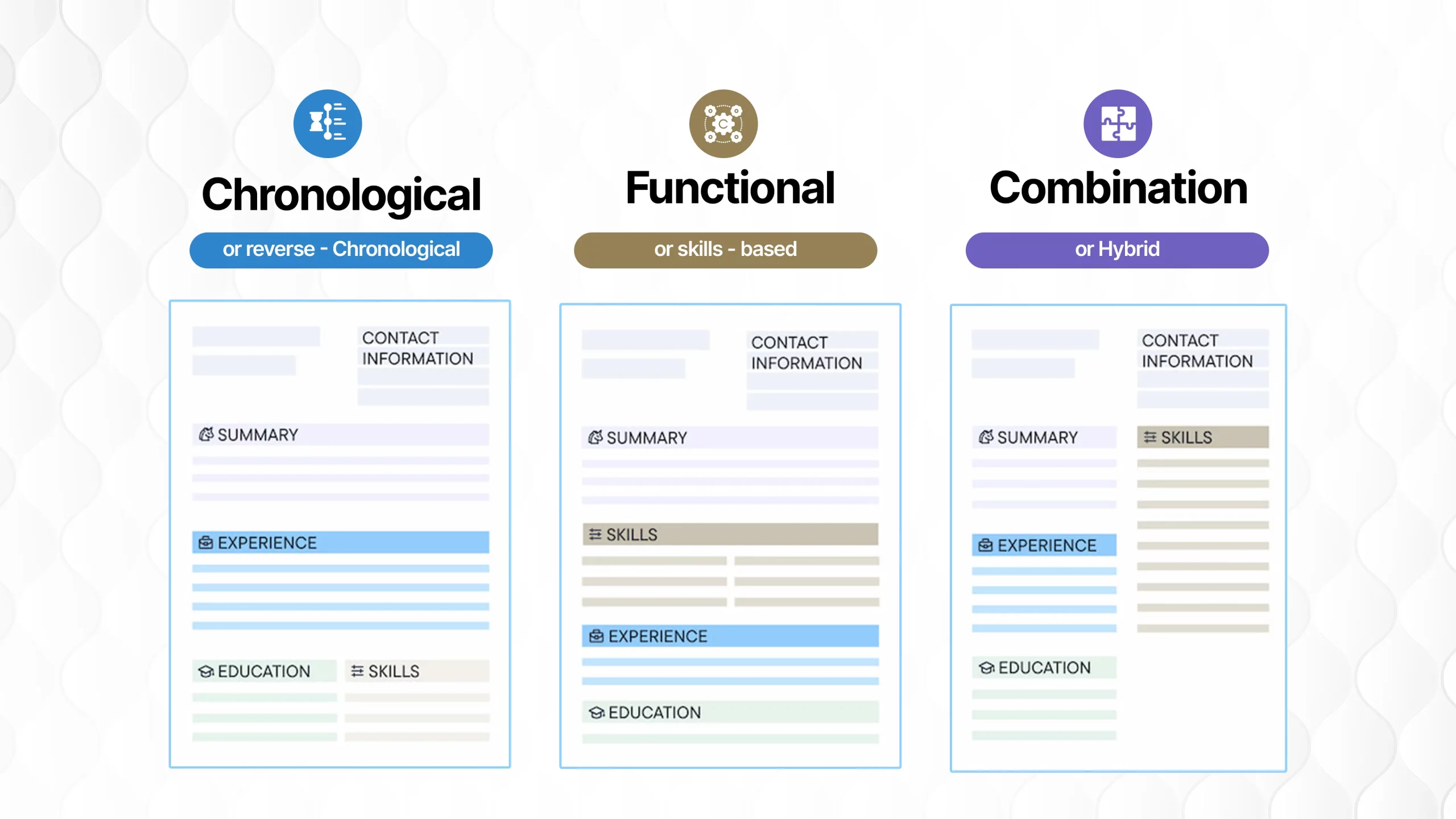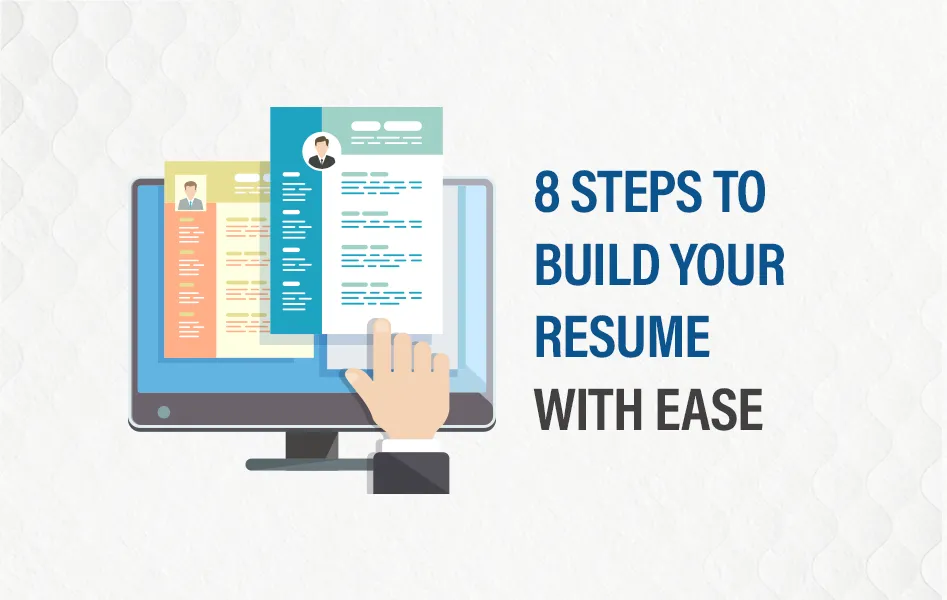- Understanding the Basics of a Resume
- How to Choose the Right Resume Format
- What Are the Essential Sections of a Resume
- How to Craft Each Section Effectively
- Design and Formatting Tips When
- Common Resume Mistakes to Avoid
- Final Checklist Before Sending Your Resume
- Conclusion
- Frequently Asked Questions (FAQs)
Crafting a professional resume can feel overwhelming and confusing, especially if you are starting your career or changing your career path. However, to build your resume and send it to recruiters with confidence, you just need to follow an 8-step guide. With these steps, you can easily crack the Applicant Tracking System (ATS) and get noticed by the hiring manager.
In this blog, we will break down the basics of resume building and the practices you must follow so that your resume comes out on top in every job you apply for.
Understanding the Basics of a Resume
Your resume is a one-to-two-page document that shows your professional experience, skills, education, and achievements in brief. Its primary purpose is to showcase you as the right candidate for the job you are applying for and convince the employer to hire you. For this, you need to stand out from the rest.
What’s the Difference Between a Resume and a Curriculum Vitae (CV)?
A resume is a concise (1-2 pages), tailored document for specific jobs. The name is common in the United States. Whereas a CV has more than 2 pages, and showcases a detailed academic/research background of the candidate. This is usually common in Europe and academia.
For most job applications, a resume will suffice. So, what are the points or information you need to include when you build your resume?
Key Sections Every Resume Should Include
- Contact Information
- Resume Summary or Objective
- Work Experience
- Education
- Skills
- Certifications, Projects, Volunteer Work (Optional)
How to Choose the Right Resume Format
As the professions are unique, and each needs a different skill set, the resume you use to apply for those positions must follow a unique format as well. Whether you are an investment banker, senior sales executive, or performance marketer, you need a strong resume to win the recruitment game. But before you build your resume, you need to know which format suits your profession or your present career status.

The different types of resume formats are as below, and you can build your resume as per your requiremnt.
Chronological Resume
For those: Several years of experience and a steady work history
Structure: List work experience in reverse chronological order
Pros: Makes it easier for recruiters to follow and highlights career growth
Functional Resume
For those: With career changes, freelancers, and those with employment gaps
Structure: Focusing on the skills rather than job history
Pros: Can shift attention from career gaps to the skills and achievements
Combination/Hybrid Resume
For those: With strong skills and relevant experience
Structure: Blend work history with skill sections
Pros: Can highlight both expertise and career progression
Tip: If you are not sure about the format selection, it is the best bet to go with the chronological one. It is usually the choice of most job seekers. So, understand the formats, and build your resume effortlessly.
What Are the Essential Sections of a Resume
Your resume must be divided into sections, with each one showcasing detailed information about your personal/professional details, skills, experience, etc. With section-wise division, the hiring manager will be able to understand your eligibility for the post they are hiring. Now, you don’t have to worry thinking, ‘how will I build my resume,’ as everything is included in the below sections.
Below is a detailed breakdown of each section of the resume.
Objective or Resume Summary
A resume summary is for experienced candidates, and a resume objective is for freshers and those looking for a career change. Don’t forget this part when you build your resume.
For example:
Resume summary: A marketing manager with 5+ years of experience in Meta campaigns, Google Ads, SEO, and brand strategy. Increased organic traffic by 40% for previous employers.
Resume objective: Recent business graduate seeking an entry-level marketing role to apply analytical skills and creativity in a dynamic business environment.
Work Experience
List your jobs in reverse chronological order (keep the most recent one first).
Use strong action verbs (e.g., developed, managed, led, optimized).
Follow the CAR method. (Challenges you faced | Actions you took to solve them | Results you got at the end)
Here is an example of how you should and should not write your work experience.
✔Strong: Increased Instagram engagement by 35% through targeted content strategies.
❌Weak: Responsible for social media posts.
Simply stating that you were responsible for some postings is not enough; you need to show that you are results-driven and will take the brand to new heights.
Education
You should write down your education details based on your current status.
If you are a recent graduate, you can add the details below:
Degree, University, Graduation Year
Honors, relevant coursework, GPA (if good)
If you are an experienced professional, write your educational qualifications below:
Degree, University, year (unless it’s a top school)
Educational qualification is important for landing a job; however, as you gain more work experience, you must focus on enhancing your skills, roles and responsibilities, and designations rather than education.
Skill Section
You can divide your acquired skills into hard (technical) and soft (interpersonal) skills when you build your resume.
Hard skills: These are your technical abilities. For example, Python, Photoshop, data analysis, etc.
Soft skills: These are your interpersonal traits. For example, your leadership abilities, communication skills, management skills, etc.
Optional Sections (only if it’s relevant for the job)
Certifications (e.g., Google Analytics, SEO)
Projects (academic, freelance, or personal)
Volunteer work (shows initiative and values)
Languages (if multilingual)
Optional Sections (only if it’s relevant for the job)
How to Craft Each Section Effectively
Proper professional summary: This is your pitch section to the HR manager. Tailor this section for each job profile. Build your resume with this professional summary.
For example,
Result-driven SEO specialist with 5+ years of experience in campaign management and local SEO. Boosted online traffic by 40% in the previous company. Seeking to leverage skills at a growth-oriented startup.
Work experience: You can use bullet points and action verbs here (e.g., led, initiated, built, developed) and quantify your achievements where possible.
Education: If you are a recent graduate, mention it above your work experience. Include your academic projects and relevant achievements.
Skills: Try to align your skills with keywords from the job description. This will help you pass the Applicant Tracking System (ATS).
To make your resume look professional and slick, keep the entire content in one format/alignment, concise, and brief. Avoid generic phrases like ‘hardworking team player,’ and proofread after you build your resume, and edit one last time.
Design and Formatting Tips When
Font & Layout: Use Arial, Calibri, or Times New Roman (10- 12pt.). Use bold and italics options sparingly for emphasis. Don’t overuse it
Margins: Keep the margins 0.5 to 1 inch
Consistency: Keep the formatting the same for headings, bullet points, and dates
Avoid over-designing: Unless you are in a creative field or have experience in designing, keep the resume design simple
Save it as a PDF: To make sure your format stays the same, convert your file/doc into a PDF (unless the company asks for a Word file).
Common Resume Mistakes to Avoid
There are some common mistakes candidate make while trying to craft a winning resume. To prevent situations like that, we have listed the pointers you need to remember when you build your resume.
Typos and grammatical errors: Always proofread your content and use AI tools like Grammarly to eliminate errors.
Using one resume for every job: Tailor your resume according to the job profile you are applying for.
Including irrelevant jobs: Avoid adding your previous jobs that are irrelevant or don’t add value to your experience for the job you are applying for.
Too much or too little information: Only add what is required for the hiring manager to grasp your experience and qualifications.
Using passive language: Use strong, active language in your resume. Passive language looks and feels effortless.
Using an unprofessional email address: Use an email address that is a combination of your name and number(s), e.g., kratika.ph@gmail.com.
Listing duties instead of achievements: Focus on what you accomplished, not just what you were assigned.
Final Checklist Before Sending Your Resume
Once you build your resume, you need to go through these 5 points before sending it to the hiring manager.
- Is the resume tailored to the job description?
- Does it include relevant keywords (for the ATS)?
- Are your achievements quantified?
- Is the content free of errors?
- Is the formatting clean and professional?
Conclusion
A well-crafted resume is your door to new opportunities. With the right format and content, you can create a polished, ATS-friendly resume that highlights your strengths and gets you noticed. Remember, your resume is a living document. Keep updating it as frequently as you can, learn new skills, and take up new responsibilities. With these tips and tools, you’ll be well-prepared to succeed in interviews.
Ready to start? Download our [free resume e-book] with graphical representations for a better understanding.
Frequently Asked Questions (FAQs)
Where can I build my resume for free?
You can easily build your resume for free on platforms like Canva, Indeed, and Zety.
What’s the best type of resume for Indian companies?
A reverse chronological resume is often preferred, highlighting your most recent experience first. When you build your resume, keep this format in mind.
What are the computer skills needed for a resume?
Common computer skills include proficiency in Microsoft Office, Google Workspace, and basic programming. Adding familiarity with software relevant to your field is a good option.
How to create a resume link?
After you build a resume, you can create a resume link by uploading your it to Google Drive or a website providing a similar service. Share that link with the hiring manager when required. You can also use LinkedIn to generate a public profile link.
What are the 7 types of resumes?
The seven types of resumes: chronological, functional, combination, targeted, mini, non-traditional, and infographic. Though there are many other types of resumes, you need to only focus on the first three types while applying for a professional job.
What is a reverse chronological resume?
A reverse chronological resume lists your work experience starting with the most recent position and working backwards.
Can I build my resume online?
Yes, you can actually build your resume online using tools like Canva, Indeed, and LinkedIn.
Can I build my resume for free?
Yes, you can build your resume for free. many platforms like Canva, Indeed, and Zety offer free resume-building tools.
Nivin Chandran is a seasoned Sr. Copywriter at Digital Nest School of Business with over 5 years of experience in writing about education, technology, business, science, and more. He has authored over 500 blogs across various industries, including IT, FMCG, F&B, Real Estate, and IoT. Nivin’s expertise and versatile writing skills make him a valuable asset in the content creation field.

